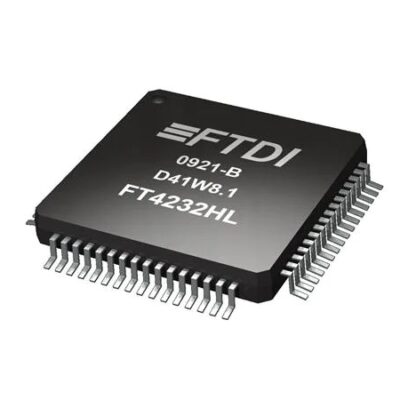FT4232HL-REEL
Part Number: FT4232HL-REEL
Manufacturer: Future Technology Devices International Ltd
Description: IC USB HS QUAD UART/SYNC 64-LQFP
Shipped from: Shenzhen/HK Warehouse
Stock Available: Check with us
ICRFQ.com - Electronic Components Distributor in China Since 2003

Part Number: FT4232HL-REEL
Manufacturer: Future Technology Devices International Ltd
Description: IC USB HS QUAD UART/SYNC 64-LQFP
Shipped from: Shenzhen/HK Warehouse
Stock Available: Check with us
| Datasheet | |
|---|---|
| Category | Integrated Circuits (ICs) |
| Family | Interface – Controllers |
| Manufacturer | FTDI, Future Technology Devices International Ltd |
| Series | USBmadeEZ-FIFO |
| Packaging | Tape & Reel (TR) |
| Part Status | Active |
| Protocol | USB |
| Function | Bridge, USB to UART |
| Interface | UART |
| Standards | USB 2.0 |
| Voltage – Supply | 3 V ~ 3.6 V |
| Current – Supply | 70mA |
| Operating Temperature | -40°C ~ 85°C |
| Package / Case | 64-LQFP |
| Supplier Device Package | 64-LQFP (10×10) |
The FT4232H is the latest generation of USB devices from FTDI. The FT4232H is a USB 2.0 high-speed (480Mb/s) UART/MPSSE IC.
The device offers up to four UARTs. Two of them can have MPSSE engines individually configured. The FT4232H now has two UART/Bit-bang ports and 2 MPSSE engines, allowing it to emulate various synchronous serial protocols.
The FT4232H has completed USB-IF Test-ID (TID) 40720024, proving that it complies with the USB 2.0 specification. The exact timing of the rise and fall times of the USB signals is dependent on the system as a whole because of the PCB layout, external components, and transient protection on the USB signals. A minor adjustment may be needed for USB compliance. This timing can be altered using a programmable parameter in the same external EEPROM as the USB descriptors. Timing may be changed when passive components are added to USB signals.
The FT4232H represents FTDI’s fifth-generation USB device. The FT4232H is an integrated circuit (IC) that converts USB 2.0 high speed (480Mb/s) to UART/MPSSE. Multiple standard serial interfaces can be configured for use. The FT4232H has four programmable interfaces that can each be controlled individually. Using an MPSSE and two independent baud rate generators, you may build up a pair of these interfaces to function in UART, JTAG, SPI, I2C, or bit-bang mode. The remaining two interfaces can be configured as either a bit-bang or a UART.
fast quad interface USB. Four distinct flexible/configurable serial interfaces are offered by the FT4232H using USB 2.0 High Speed (480Mbits/s).
The FT4232H has a USB protocol engine that controls the USB 2.0 High-Speed interface (UTMI) and the Universal Transceiver Macrocell Interface (UTMI).
The FT4232H is a phase-locked loop (PLL) that operates from 12 MHz to 480 MHz and includes an integrated +1.8V Low Drop-Out (LDO) regulator. Each of the channel’s Tx and Rx data buffers is 2 kilobytes. On a single chip, the FT4232H successfully incorporates the entire USB protocol.
This functions as a timeout to flush small data packets back to the PC and is a driver feature. While 0ms to 256ms can be changed, the default value is 16ms. Every high-speed micro-frame has a packet transport at 0ms delay.
Channels A, B, C, or D of the FT4232H can be set up as bit-bang interfaces. Bitbang modes come in two flavors: synchronous and asynchronous.
Both the traditional BM Bit-Bang mode and the asynchronous variant are functionally equivalent. Any channel set to asynchronous bit-bang mode will clock data sent generally to the device onto the parallel I/O data pins (those which have been configured as outputs). Every single input/output pin can be set up differently. The baud rate generator sets the data transmission rate. In addition to the baud rate clock ticking, new data must be written for the information to evolve. The pins will retain the last written value if the channel is not further updated.
When using synchronous Bit-Bang mode, only the parallel I/O port pins are modified when data is sent from the USB interface to the parallel interface. Then, data is sent to the pins from the USB Rx FIFO buffer. Once the parallel interface has been written to, the USB Tx FIFO can only accept data from the parallel pins. If the USB TXFIFO of the FT4232H is filled, the parallel interface won’t transfer any data. The mode is called “Synchronized Bit-Bang.” Before being transported over the USB RxFIFO in synchronous bit-bang mode, data is first read from the parallel I/O pins on the data bus. Because it delays the output by one byte, you will need to give an extra byte if you want to decode the data in the most recent byte.
There are three distinct FT4232H packaging options. Optional LQFP-64, QFN-64, and VQFN-56 packages are available for the FT4232, with the FT4232HL, FT4232HQ, and FT4232H-56Q, respectively.
Are you prepared to order the FT4232HL-REEL, or are you more interested in more details? Contacting ICRFQ is the best course of action if you’re trying to find Chinese-made electrical components online. We will go above and beyond to ensure you receive the best products for the lowest cost.
WhatsApp us